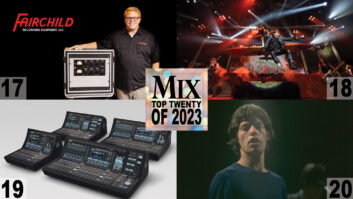ROOM-TUNING TIPS & TRICKS
The TEF System 20 is an accurate and versatile measurement tool and-in terms of offering fine resolution in the time and amplitude domains-it’s my preferred instrument. Here are some insider techniques that I would like to share.
USE YOUR EARS
The placement of the measurement microphone represents one small point in a very large sound field. The microphone could be placed in a major acoustic cancellation or null that only occurs in a small area, or it could be at the best place in the house. We need to know how the overall room is performing and where and what the problems are.
You can save an enormous amount of time by investigating the space with your ears. I carry Post-Its when I walk the room. When I find a problem, I write it on a Post-It and stick it on a seat to mark one of the positions where you can set up the TEF to investigate that particular problem.
BAND-LIMITED PINK NOISE
The use of band-limited pink noise really helps locate and define the acoustical problems of a space. I use two different bands, noise-shaped so that the energy is 6 dB down at the octaves. One band is centered about 6 kHz, and the other is centered around 125 Hz.
The 6kHz band-limited noise is the most useful. It helps me to hear exactly where the speaker is aimed, points out reflections from balconies and sidewalls, and tells me how the cluster is combining and how severe the problems are. TEF time measurements will indicate that reflections are coming back from a surface, but the band-limited pink noise lets me hear it, so aiming, adjusting and determining the coverage area of a speaker becomes easy. The 125Hz band-limited pink noise helps uncover low-frequency problems, such as lobing and incoherent subwoofer/bass.
THE MIX POSITION
Reflections from the top of a mixing board can cause both a significant hole in the frequency response (cancellation) and a shift in the acoustical center for the image. I was one of the first to describe this problem, and the realization was a direct result of seeing the data on a TEF.
When I set up a mix position, I am very picky about the arrival time and the arrival level. This results in a perfectly centered image. TEF’s microsecond resolution allows me to see phase with a very high degree of accuracy. Remember, phase is an expression of time, while the speed of sound is a constant. Accordingly, by examining the phase of the arrival from the left loudspeaker and from the arrival from the right loudspeaker, at a given frequency, I can find the exact golden spot for the mix position.
When choosing a frequency, try to stay in the middle of the bandpass for the device, i.e., stay away from the crossover frequency. Additionally, in order for the image to be perceived as centered, the amplitude or loudness must also be precisely matched.
The TEF shows me the level for a given frequency to 11/410 of a dB. Now some people may ask whether it is possible to hear a fraction of a dB, and the answer is that in the mid-high frequencies even a fraction of a decibel offset in level will shift the image left or right. Once the time and magnitude are matched, I then use the TEF’s pink-noise module and a digital equalizer to produce a shaped pink noise.
SPEAKER MEASUREMENTS
As with most audio devices, TEF is only as good as the knowledge of the person using it. In recent years, I have seen published articles that used TEF measurements to evaluate speaker systems. Some of these measurements exhibit telltale anomalies caused by measurements being taken too close to the speaker. Reasonably accurate evaluations of multi-way speaker systems require making the measurements at several times the maximum dimension of the speaker or speaker array. The measurement should be made as close to the on-axis plane as possible and with the total understanding of the TDS ellipsoidal space window.
In conclusion, repeatability, accuracy and an understanding of the physics of the procedure are essential before making any measurement. Last but not least, we must not let the memory of Richard Heyser go by the wayside; Dick gave us very valuable measurement tools and a great insight into the many domains of audio.
TEC award-winning acoustician Chips Davis has designed top studios, broadcast facilities and performance venues worldwide.





